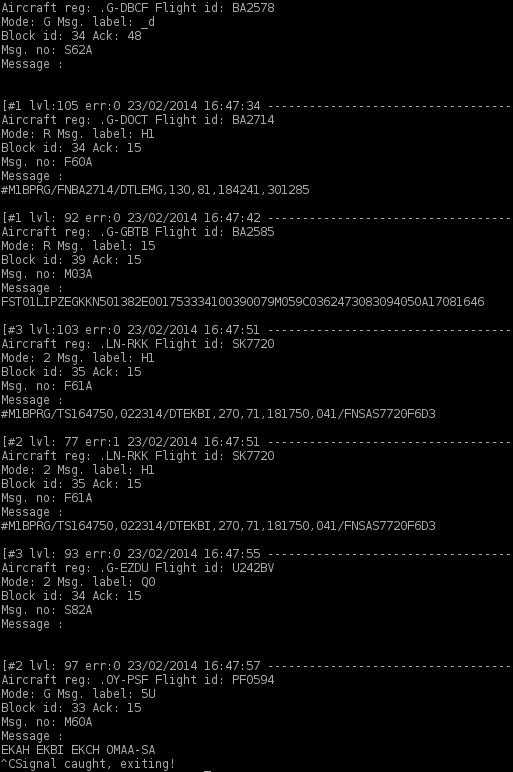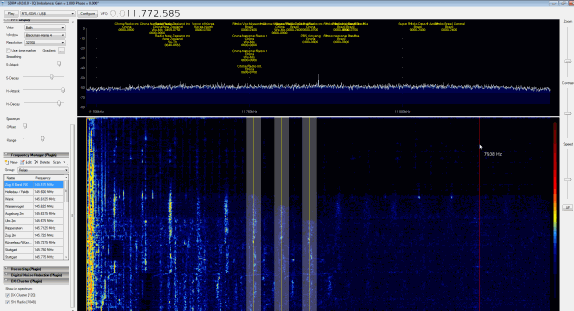Recently a reader wrote in to correct some mistakes regarding the Linrad software on our big list of RTL-SDR supported software post. Along with those corrections this reader also wanted us to know how much of a superior receiver he believes Linrad and the special Linrad RTL2832U E4000 drivers are.
If you are unaware, Linrad is an RTL-SDR supported SDR receiver program (similar to SDR#/HDSDR/SDR-RADIO) with very advanced features, but also a relatively steep learning curve.
The reader who wrote in wants to remain anonymous, but we will say that as far as we can tell he is not affiliated with the development of Linrad, and is simply a Linrad user and fan.
The first point the reader would like to make is about the Linrad RTL-SDR drivers special linearity mode.
[The Linrad drivers] main advantage for RTL E4000 based dongles isn’t the weak signal mode. It’s actually the linearity mode that provides significant dynamic range improvements over the existing osmocom drivers (http://www.sm5bsz.com/linuxdsp/hware/rtlsdr/rtlsdr.htm).
The author of Linrad, Leif, is very knowledgeable in both RF and SDR technology. It is extremely rare to be skilled in both. Leif submitted his modified RTL drivers to the osmocom team, but as best as I could tell, it became quite apparent the osmocom team does not have a firm grasp of the concept of dynamic range, and receiver performance metrics. Leif’s code was rejected for cosmetic reasons. It is a large shame, but highlights the extremely poor understanding the SDR community has of basic receiver performance metrics.
Your readers should take a look at this video.
http://www.youtube.com/watch?v=cVU5X1d2XYU
Shortly after the 4 minute mark, a strong signal is introduced into all four dongles. This signal is swept across so at times it is not present in the frequency span the dongles are listening to. Two of the dongles are E4000 based RTL SDRs, and naturally the Linrad one is using properly optimized settings. Notice how the properly optimized Linrad drivers show a nice calm spectrum, free form spurs, harmonics, images and other offending signals when the signal generator is introducing a signal several MHz away from the listening frequency span.
Notice how the osmocom dongles are essentially trashed, where nothing but the strongest of strong of signals could be heard, and even then it’s likely to have distortion. This is what happens in the real world. For most people, when they connect their RTL to an outdoor antenna, their receive performance is not limited by the noise figure of the dongle, but rather by its dynamic range. Leif is the _only_ SDR program author that fully understands this.
Note that if you just want to try the modified Linrad E4000 drivers on SDR#, there is this modification that can help.
As well as the driver issue the reader also highlights some advanced features of the Linrad SDR program itself which are not present in most other similar software defined radio programs.
1) Proper I/Q calibration. Other programs at most only allow you to calibrate a SDR for a single part of the spectrum. This is not proper, because at a few kHz away, the I/Q balance will shift and the calibration will no longer be accurate. Linrad allows you to calibrate for many frequency intervals across the SDR’s bandwidth, resulting in a flat frequency response and true I/Q phase and amplitude balance calibration.
2) Due to frequency response calibration using a pulse generator (http://www.sm5bsz.com/linuxdsp/flat/sqrpulser.htm), Linrad has a phenomenal “smart” noise blanker to remove (blank) pulse noises. Signal with no blanker http://sm5bsz.com/linuxdsp/blanker/leon2001/leo-nob.mp3. Here is the same recording, but with the “magic” of a fully calibrated Linrad blanker. http://sm5bsz.com/linuxdsp/blanker/leon2001/linleo.mp3. No other SDR software’s blanker can produce results like this.
3) Linrad can multicast its output to multiple computers or directly to a single computer over the network. You can also run multiple instances of it on the same computer.
4) Linrad’s waterfall is effortlessly optimized to display signals ~10dB (or more) weaker than what you can hear. No other SDR program allows this “out of the box”. Some will achieve similar performance by adjusting various settings, but will require more averaging (slower water fall speed) to achieve a similar waterfall “visual” SNR as Linrad.
5) Linrad allows varying of various sample and time settings adjustments to make extremely precise measurements such as frequency stability (http://www.sm5bsz.com/lir/sdrcmp/jan14/stab432.htm and http://www.sm5bsz.com/lir/sdrcmp/fqstab/fqstab.htm) noise figure (http://www.sm5bsz.com/lir/nf/nf2.htm) and phase noise (http://www.sm5bsz.com/osc/osc-design.htm)
6) Linrad supports two RF channel input for diversity reception.
7) Linrad’s AGC is superior to that of other SDR programs and analog receivers, often vastly superior (http://www.sm5bsz.com/lir/agctest/agctest.htm)
8) Proper and adaptable AFC to place a narrow filter around a signal that drifts (http://www.sm5bsz.com/linuxdsp/afc/meteor.htm)
Finally, as a conclusion the reader writes
In short, if you want to listen to FM broadcast signals from 88-108 MHz, take your pick of SDR programs, it doesn’t matter when picking up a 50+ kW transmitter a few dozen kilometers away. If you want top performance, learn about DSP, RF, performance metrics, and so forth, there is only one suitable program: Linrad. Nothing else comes close.


